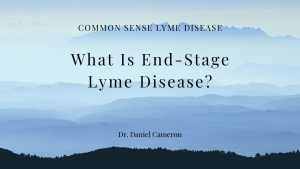Call for your appointment today 914-666-4665 | Mt. Kisco, New York

The PG(Bb) fragments likely “contribute to inflammation during infection and in cases of post-infectious Lyme arthritis.” In a mouse study, the authors found “that PG(Bb) alone was sufficient to induce acute arthritis.”
Furthermore, Jutras and colleagues suggest that “immune responses to PG(Bb) and autoantigens may contribute to pathology, even after the infection itself has been cleared.” Varying disease severity in patients with Lyme arthritis may be due to differences in specific PG(Bb) immune responses, they claim.
[Author’s note: Jutras and colleagues assume that the infection has resolved. However, there is no reliable test to show that a Lyme disease infection has cleared.]
Jutras and colleagues raise the question: How can PG(Bb) material remain in the synovial environment for an extended period (weeks to months) after appropriate antibiotic treatment?
They propose three possibilities:
- PG material may be left behind after bacterial killing.
- Macrophages may store PG in vesicles.
- PG-containing immune complexes may accumulate in the synovial fluid.
To dampen the immune response to PG(Bb), Jutras and colleagues suggest using “disease-modifying anti-rheumatic drugs, primarily hydroxychloroquine or methotrexate.”
In addition, they recommend “targeting innate immune responses with medications, such as TNF or NF-κB inhibitors, for the treatment of such patients.”
[bctt tweet=”Persistent antigen (B. burgdorferi peptidoglycan) may cause ongoing inflammation in patients with Lyme arthritis, according to study. ” username=”DrDanielCameron”]
Lastly, the authors found that B. burgdorferi releases PG(Bb) fragments during growth, suggesting that “PG(Bb) may play a broad role in the multifaceted pathogenesis of Lyme disease beyond Lyme arthritis.”
One must ask, however: Could an active Lyme infection be driving the persistent antigen PG(Bb)?
The authors did not propose the possibility that PG(Bb) material might be caused by a persistent infection. If this was considered, they might have suggested antibiotic treatment rather than immune-modulating therapies.
Related Articles:
What if a pronounced TH17 cytokine response in Lyme arthritis was caused by a persistent infection?
References:
- Jutras, B. L., et al. (2019). “Borrelia burgdorferi peptidoglycan is a persistent antigen in patients with Lyme arthritis.” Proc Natl Acad Sci U S A 116(27): 13498-13507.




Hi, 3 weeks ago I developed a blood clot in my. Left leg. N celulitis was treated with antibiotics n Eliquis, after this period of time I am experiencing extreme pain in the joint, fever , chills and confusion. .Approx 8 yrs ago I had Lyme disease and was treated for 30 days on the prescribed drug. I feel what i am experoencing today is exactly what I was experiencing 12 years ago. Is it possible for the Lyme disease to resurface with no new bites . it’s all very confusing, spend 6 hrs in the ER on 4/7/2020. After numerous blood text, urine test n eras all came back negative. Leaving them completely puzzled. Yet not willing to do a Lyme disease test. Anything you can recommend as to what direction I should go next, would be so very very grateful. Thank you
I have seen patients where the stress of one illness brings out Lyme disease. It doesn’t even have to be the same tick.